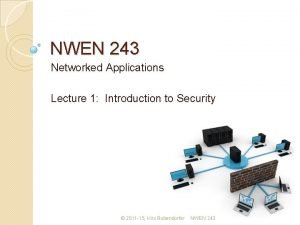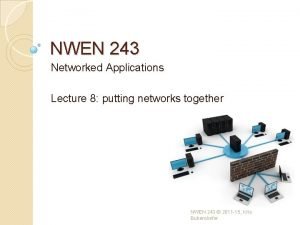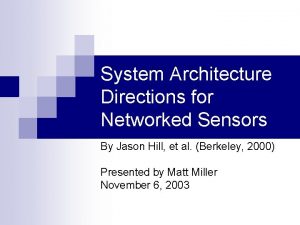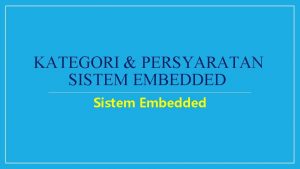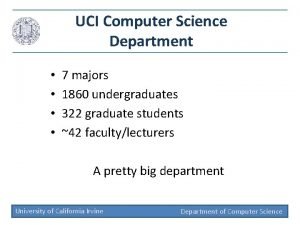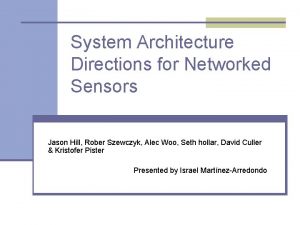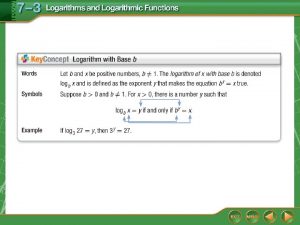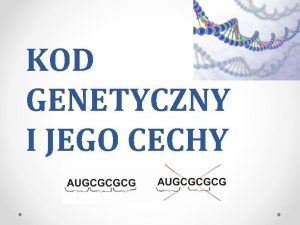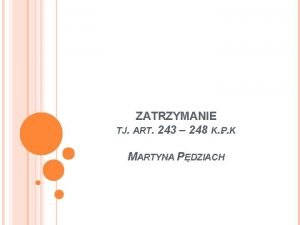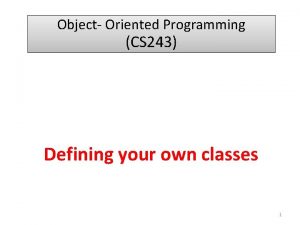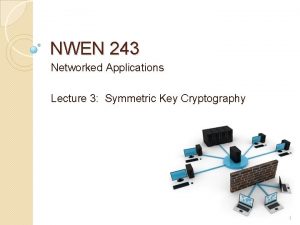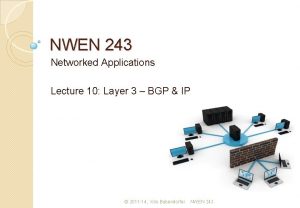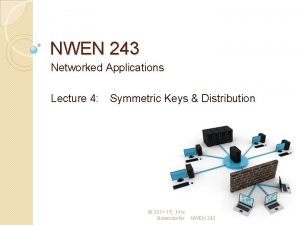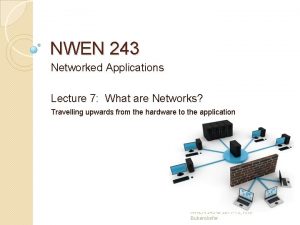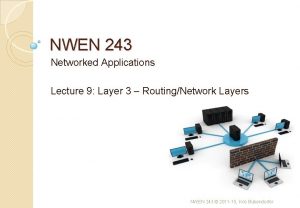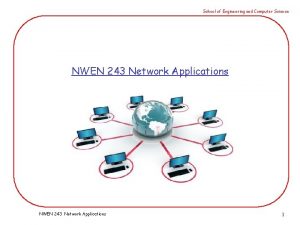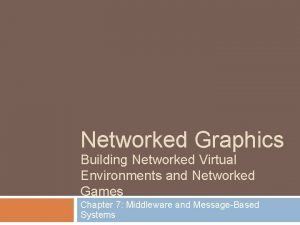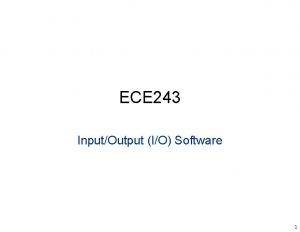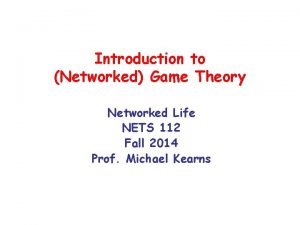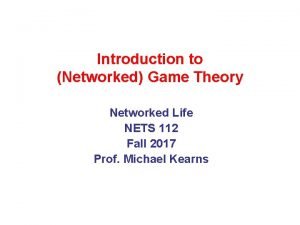NWEN 243 Networked Applications Lecture 5 The Key
























- Slides: 24

NWEN 243 Networked Applications Lecture 5: The Key Problem & Asymmetric Cyphers © 2011 -15, Kris Bubendorfer

Key Distribution Center (KDC) How does the KDC enable Alice and Bob to determine a shared symmetric secret key to communicate? KDC generates SK 1 KA-KDC(B) Alice Learns SK 1 KA-KDC(SK 1, KB-KDC(A, SK 1) ) KB-KDC(A, SK 1) Bob learns SK 1 & communicates with Alice and Bob learn the SK 1 (session key) and ‘authenticate’ at the same time. © 2011 -15, Kris Bubendorfer NWEN 243

Key Distribution Center (KDC): Simpler Version How does the KDC enable Alice and Bob to determine a shared symmetric secret key to communicate? KDC generates SK 1 KA-KDC(B) KA-KDC(SK 1) Alice Learns SK 1 KB-KDC(SK 1) Bob learns SK 1 & communicates with Alice What are the disadvantages of this protocol? © 2011 -15, Kris Bubendorfer NWEN 243

Reminder: The Problem of Keys �Symmetric encryption requires key exchange - parties must ‘know’ each other ahead of time. �In the 1970 s COMSEC was responsible for transporting tons of keys each day. � 2 parties wishing to communicate had to rely on the ‘trusted’ third party to deliver their keys. �For a long period of time solving the keydistribution problem was the ‘Holy-Grail’ of cryptography (aka, impossible). © 2011 -15, Kris Bubendorfer

The story of a Locked Box � Alice wishes to send Bob a personal message. � Alice places her message in an iron box, and secures it with a padlock. � Alice puts the box in the mail and keeps the key. � When the box reaches Bob, he is unable to open it as he does not have a key. � The only way Bob can open it is if Alice has previously given him a copy of the key. � Or is it…. © 2011 -15, Kris Bubendorfer

The story of a Locked Box � Alice padlocks the box. � Sends the box to Bob, and keeps the key. � Bob cannot open the box, but places his own padlock on it in addition to Alice’s. � He sends the box back to Alice. � Alice removes her padlock, and � Sends the box back to Bob, � Bob can now remove his padlock and read the message! � No prior key exchange was needed. © 2011 -15, Kris Bubendorfer

The story of a Locked Box � The problem is, when we apply this to encryption, � The order of the encryptions matters. B(A(x)) A(B(x)) � What was needed was a scheme where this order did not matter. � Whitfield Diffie and Martin Hellman attempted to do this by looking at one-way functions, � those that are easy to do in one direction, but almost impossible to reverse. © 2011 -15, Kris Bubendorfer

One Way Functions ? © 2011 -15, Kris Bubendorfer

Diffie-Hellman-Merkle �DHM was the break through key exchange protocol in the mid 70 s. �Paint Analogy: ◦ Bob, Alice each have 1 litre of yellow paint. ◦ Bob and Alice wish to exchange keys, so add a little of their own secret colour to the pot. ◦ Bob and Alice exchange pots. ◦ Bob adds his secret colour to Alice’s pot, and Alice adds her secret colour to Bob’s. ◦ Both pots are now the same colour. © 2011 -15, Kris Bubendorfer

Diffie-Hellman-Merkle �The central idea is based on the one way function: Yx (mod P) with Y < P �Yx (mod P) is very easy to compute, but ◦ Is very hard to reverse, without building a huge table of solutions. ◦ This is because computing one ‘reversed answer’ does not give any hint or clue about another. ◦ The bigger Y and P the larger the search space. © 2011 -15, Kris Bubendorfer

Deffie-Hellman Key Exchange Step 1: Let’s agree on a prime number p and a base g Step 2: Alice chooses a secret number ‘a’ and sends the to Bob (ga mode p) Step 3: Bob chooses a secret number ‘b’ and sends Alice (gb mode p) Step 4: For the Key: Alice computes (gb mode p)a mode p Step 4: For the Key: Bob computes (ga mode p)b mode p Notice that p and g need not be protected. So, an attacker could have them

Diffie-Hellman-Merkle � Alice and Bob establish two values for Y and P on a public channel, say 7 and 11, giving: 7 x (mod 11) Alice chooses her key: x = 3. 73 (mod 11) = 2 Alice sends 2 to Bob over the public channel Alice Takes Bobs number 4 and computes: 43 (mod 11) = 9 Bob chooses his key: x = 6. 76 (mod 11) = 4 Bob sends 4 to Alice over the public channel Bob takes Alice’s number 2 and computes: 26 (mod 11) = 9 This was a most significant breakthrough in cryptography – to establish a secret key with no physical key distribution. � DHM is used in Open. ID. � � https: //youtu. be/YEBfamv-_do? t=2 m 18 s © 2011 -15, Kris Bubendorfer

Public Key Encryption � In 1975 Diffie proposed an asymmetric cypher scheme for public key encryption. � The central idea is that Alice has two keys, one public and one private. � Alice keeps her private key to herself, but lets everyone know her public key. � Anyone with Alice’s public key can encrypt a message for Alice, but only Alice can decrypt it with her private key (secrecy). � Alice can also encrypt things with her private key, and anyone with her public key can decrypt it. They know Alice sent the message, as only she knows he public key (authentication). � The problem was there was no known one-way function to make it work – the race was on. © 2011 -15, Kris Bubendorfer

Public Key Encryption Message, M KX+ attack at dawn unless it rains. encryption method KX- KX+(M) Cyphertext decryption method KX-(KX+(M)) = M KX+ X’s Public Key, KX- X’s Private Key attack at dawn unless it rains. © 2011 -15, Kris Bubendorfer

RSA Analogy � Alice creates a large number of padlocks, and keeps the key herself. � Alice deposits her padlocks in a ‘post office’. � When Bob wants to send a package to Alice he obtains an ‘Alice’ padlock and closes it to seal the message. � Bob can no longer open the package, only Alice can. � This is harder mathematically, than physically. The idea in RSA is to use large primes that are difficult to factor, and a one way (mod) function. © 2011 -15, Kris Bubendorfer

RSA (Rivest, Shamir, Adleman) �Two steps to RSA ◦ Choice of public and private keys ◦ The encryption and decryption algorithms © 2011 -15, Kris Bubendorfer

RSA – choosing the keys �Alice picks two giant primes p and q ◦ Product pq should be about 1 K-4 K bits N = pq Z = (p - 1)(q - 1) �Choose some e < N relatively prime to Z �Alice’s public key is (N, e) �Find d such that (ed) mod Z = 1 ◦ Uses Euclid’s algorithm to quickly find the GCD. � Alice’s private key is (N, d) © 2011 -15, Kris Bubendorfer

RSA – the algorithms. �Encryption C = Me mod N �Decryption M = Cd mod N �An elegant but expensive process! © 2011 -15, Kris Bubendorfer

Tiny RSA Example �p = 3, q = 11 �N = pq = 33 �Z = (p-1)(q-1) �Choose = 20 e < N and relatively prime to Z ◦ e = 3, no common factors with Z �Find d such that 3 d (mod 20) = 1 ◦ d=7 Public key = (33, 3) Private key = (33, 7) © 2011 -15, Kris Bubendorfer

Tiny RSA Example � Bob wishes to send message M = 7 to Alice. � Bob encodes with Alice’s public key e and C = Me mod N ◦ C = 73 mod 33, ◦ C = 13 � Alice decodes with private key and M = Cd mod N ◦ M = 137 mod 33 ◦ M=7 � Sam attempts to decode with the public key M = Cd mod N ◦ M = 133 mod 33 ◦ M = 19, which is incorrect. © 2011 -15, Kris Bubendorfer

Reversability Can run in reverse: encrypt with private key and decrypt with public key. � Bob encodes with C = Md mod N ◦ C = 77 mod 33 ◦ C = 28 � Alice decodes with M = Ce mod N ◦ M = 283 mod 33 ◦ M=7 © 2011 -15, Kris Bubendorfer

Try this �P = 11 and q = 5 �Generates public and private keys © 2011 -15, Kris Bubendorfer


The problem is, �It is mathematically expensive to perform RSA encryption. �Symmetric keys are much cheaper. �PGP (Zimmerman 1991) pretty good privacy combined both. ◦ RSA to establish authenticity, and ◦ RSA to securely transport the… ◦ symmetric conversation key. © 2011 -15, Kris Bubendorfer
 Cuneiform tablet
Cuneiform tablet Nwen 243
Nwen 243 01:640:244 lecture notes - lecture 15: plat, idah, farad
01:640:244 lecture notes - lecture 15: plat, idah, farad Networked insurance services
Networked insurance services Processor pool model
Processor pool model System architecture directions for networked sensors
System architecture directions for networked sensors Unit 32 networked system security
Unit 32 networked system security Networked system solutions
Networked system solutions Fully networked vehicle
Fully networked vehicle Networked outdoor lighting
Networked outdoor lighting Contoh networked embedded system
Contoh networked embedded system Uci computer science
Uci computer science System architecture directions for networked sensors
System architecture directions for networked sensors Networked digital library of theses and dissertations ndltd
Networked digital library of theses and dissertations ndltd Networked sensor array
Networked sensor array Trama odissea in breve
Trama odissea in breve How to graph log functions
How to graph log functions Każdy nukleotyd wchodzi w skład tylko jednego kodonu
Każdy nukleotyd wchodzi w skład tylko jednego kodonu Article 243 zg
Article 243 zg Article 243
Article 243 248 kpk
248 kpk Cs 243
Cs 243 Vibs 243
Vibs 243 ³ log
³ log Przedszkole nr 243
Przedszkole nr 243
